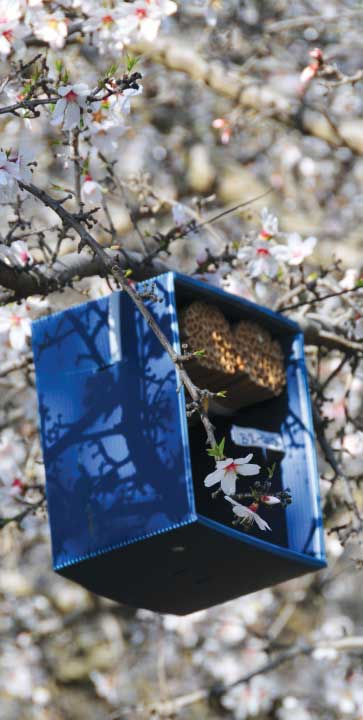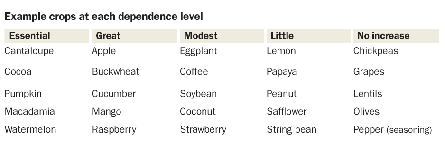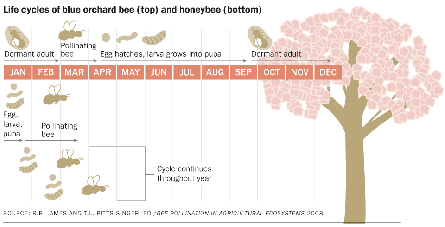Backup Bees
Luring and taming wild pollinators for help on the farm
Farms of the future could offer some strange sights, and California isn’t a bad place to go searching for them. On the edge of a yet-to-be-planted field northwest of Bakersfield, for example, stands what looks like a white clothes closet that has run away from home.



It’s a bee lock. Instead of keeping air from escaping, the way an air lock on a submarine or space station does, this box will prevent bees from zipping out of a five-acre mesh tent, explained pollination biologist Gordon Wardell of Paramount Farming during a tour last winter.
At the time of the tour, the tent was under construction, with rows of sturdy poles marching away from the bee lock under swoops of fine gray mesh. But by springtime, mesh will enclose the entire field. Red, yellow and blue nesting boxes will dangle from the poles in an experiment in raising bees that may one day pollinate some of Paramount’s thousands of acres of almond trees.
Wardell will not be rearing honeybees, the mainstay of farmers for centuries. Instead, he hopes to create a workforce of tens of thousands of blue orchard bees, species Osmia lignaria. These small, dark, mild-mannered creatures with a vest of white fuzz have no interest in making honey or joining in colonies the way honeybees do. But blue orchard bees do visit almond trees, and as a female collects pollen for her eggs, she inadvertently transfers some of it from flower to flower. Wardell hopes the blue orchard bees will serve as a backup, or maybe a partner, to the increasingly expensive and beleaguered honeybee pollinator. The blue orchard bees, he says, could be the farm’s “insurance.”
In days when honeybees face increasing threats from diseases and pesticide-intensive farming, interest is growing in such “insurance” pollinators. The blue orchard bees are just one example of an alternative to honeybee pollination on the buzzing edge of research.
Biologists are finding that free-ranging wild pollinators dropping by certain farms for lunch can deliver enough pollen to render honeybees there unnecessary. Other pollination researchers, including Wardell, are bee-deep in devising new ways to domesticate wild insects for managed pollination on farms. Rearing a new kind of six-legged worker requires pioneering on all levels, from basic physiology to nest decoration.
But Wardell and other hard-core optimists are getting to work. Standing in his partly unpacked lab across from the future tent, he points to a whiteboard with a list of problems he needs to solve before blue orchard bees can become regular farming participants. “There’s no doubt in my mind it can be done,” he says.
Bees in one basket
California’s almonds have good-news, bad-news pollination. The remarkable honeybee is able to sustain a vast industry, but that means a vast industry has come to rest on a single insect.
While some of the world’s most important food plants — such as corn — can fertilize themselves, most almond flowers can’t. And while corn also gets delivery help from wind, the pollen of the almond flower isn’t wind-friendly.
So the United States’ whole $2-billion-plus-a-year almond-growing enterprise depends on animal couriers. And almonds are not alone. Crops that account for 35 percent of food production worldwide, including apples, cherries, coffee, mangoes, tomatoes, on down to zucchini, rely to various degrees on animals. Not only do such plants need insects, but they are needed in mind-boggling numbers.
Wardell started his winter tour of the almond world by driving away from Bakersfield through blue-gray fog. Trees lined the highway in eerie, repetitive ranks. Each row flicked by the truck window with the same spacing and same height. After miles, a sibling domain of trees planted at a different time and thus of a different height abruptly took over. The new trees repeated and repeated.
In spring, the almond trees among these orchard regiments will fluff into clouds of blossoms with just a few weeks to attract insect go-betweens. As the pollination czar for Paramount Farming, Wardell contracts with commercial beekeepers to rent 90,000 honeybee hives, which are deployed one or two per acre.
About 1.5 million bee colonies, mostly from out of state, will converge on California’s almond fields. And after the almond petals fall, beekeepers will send their colonies on to the next assignment, as another crop’s season begins.
But honeybees are beset by an increasing number of menaces. Varroa destructor mites and Nosema ceranae gut parasites can weaken and kill colonies. Since 2006 the still-unexplained colony collapse disorder has been striking otherwise healthy hives and causing most of the workers to vanish over the course of a few weeks (SN: 6/19/10, p. 15). And like other migrant farmworkers, honeybees face risks from exposure to pesticides as well as from the stress of a nomadic life. With all these troubles, a new generation of large-scale beekeepers hasn’t replaced all the retirees in this increasingly uncertain industry.
Today’s nationwide supply of movable honeybee hives, at 2 million hives or somewhat more, is only half what it was in the mid-1940s, says Eric Mader of the Xerces Society, an insect-focused wildlife conservation group in Portland, Ore. Yet the U.S. acreage needing pollination roughly doubled during the same time.
“The honeybee is not about to go extinct,” Mader says, “but we are well positioned to see rising food prices.”
Relying on just one species for the majority of crop pollination is risky, warns Rachael Winfree of Rutgers University in New Brunswick, N.J. Though worldwide production of pollinated crops hasn’t yet declined, some emerging pest or disease that slams honeybees could put a lot of beloved foods at risk. “We’re putting all our eggs in one basket,” she says.
Wild side
Thankfully, honeybees are hardly the only pollinators on the planet. Many of the world’s 18,000 or so types of non-honeybee bees visit crops. And creatures other than bees stop by farm fields too, including little flying midges that pollinate the species of Theobroma that provides the world with chocolate. So as concern over honeybees grows, so does interest in what wildlings are dropping in, with no rental charges.
“Most growers don’t know whether they need honeybees or not,” Winfree says. A pitiful crop could result not just from a lack of honeybees, but from mistimed pesticide or fertilizer application or a myriad other mishaps of agriculture.
While checking the need for honeybees in watermelon fields in New Jersey and Pennsylvania, Winfree and her colleagues found 46 native bee species visiting the fruit’s flowers. Using a computer simulation to analyze bee visitors and the pollen grains they delivered, Winfree found that wild bees could have fully pollinated the crop by themselves in 21 out of 23 farms.
Her study doesn’t mean that honeybees aren’t necessary, she says. “They’re very necessary. They’re just not necessary for all types of farm systems.” These watermelon farms were small compared with California agriculture, and they may have gotten a boost from shrubby refuges where wild species abound.
In the search for wild pollinators, pumpkin and squash growers have the advantage of their own private bee species. Females of Peponapis and Xenoglossa species, nicknamed squash bees, collect pollen as baby food only from squashes and their closest relatives, explains pollination biologist T’ai Roulston of the University of Virginia’s Blandy Experimental Farm in Boyce.
Out of 20 farms growing pumpkins in Virginia and Maryland, at least 13 received full-service wild pollination, Roulston and a colleague reported in 2009. And in an ongoing study in Pennsylvania, nine out of 11 farms had enough hardworking squash bees in 2010 to make renting honeybees unnecessary, says horticulturist Alex SurcicÄ of the Penn State Cooperative Extension in Franklin County.
To help farmers determine if they have enough squash bees, SurcicÄ wants to develop a census technique that takes advantage of a squash bee’s nighttime habits. Before squash or pumpkin flowers close up around midday, bees settle into a floral sleeping bag for the night. SurcicÄ thinks farmers could estimate the bee population at the beginning of the season by collecting spent blooms at night and seeing how many of the bees emerge in the morning. Too few, and it’s time to scramble for honeybee rentals.
A taming task
Growers who really do need an alternative honeybee — a pollinator species they can summon in vast numbers or deploy in a predictable way — are tackling the domestication of wild insects.
Steve Hanlin and Sharon McClurg have no choice but to rely on domesticated pollinators. As entomologists at the U.S. Department of Agriculture’s North Central Regional Plant Introduction Station in Ames, Iowa, the researchers have learned some practical lessons about honeybee alternatives.
The station maintains breeding lines of important plants from corn to medicinal Echinacea. And when scientists need fresh seed from a particular line, Hanlin and McClurg step in to provide pollinators. Mingling pollen across breeding lines would defeat the purpose of preservation, so the rule is pollination in a cage; no wild wanderers here. The researchers work not just with honeybees but also with five other pollinators, and are looking for more. Bonus points go to insects that don’t sting the people who have to work caged too.
Flies don’t sting, but their place in the farming world is one with an asterisk. Hanlin and McClurg have found that houseflies and bluebottle flies do quite well on broad, simple flower heads, such as carrot flowers, but not as well with complex blooms.
Also there’s the rearing. Bluebottle larvae normally feast on rotting meat, and even a special meatless diet made the building stink. “Like a bad diaper pail,” McClurg says.
When Hanlin had to collect the young flies from their broth, he wore a face mask and chewed peppermint gum for olfactory distraction. He has concluded that raising the flies in-house is not financially worthwhile, at least not at a small scale. His most important discovery: a company in Idaho that raises bluebottle flies to sell.
Raising bees isn’t so hard on the nose but has its tough moments too. The alfalfa leafcutting bee, one of the most intensively managed among alternative pollinators, for example, refuses to stick out its tongue when its antennae are tickled with sweets. And that quirk may force a change in the way researchers study how farmers could make nesting sites more alluring.
Unlike honeybees, many alternative pollinators don’t nest in colonies, so farmers can’t haul an existing hive into a field and be done with nest location. Each solitary bee arrives in a field nestless and chooses a home, possibly where the farmer wants the bee but quite possibly not. To keep alfalfa leafcutting bees and other helpers near a crop, a farmer needs to lure them to a prefab home, so the farmer has to know what the bees like.
A standard test for honeybee preferences relies on the bees’ reflexive response when a bit of sucrose is touched to their antennae. But when Cory Stanley of Utah State University in Logan and Theresa Pitts-Singer of the Department of Agriculture’s bee lab in Logan tried to design a similar test for alfalfa bees, the insects’ tongues wouldn’t budge.
A previously unrecognized feature of at least some solitary bees is this difference in the proboscis reflex, the researchers reported last year in the Journal of the Kansas Entomological Society. Now researchers are developing other tests that might reveal the types of odors that could attract bees to a farmer’s housing offerings.
Another challenge of domesticating pollinators also comes from their non-honeybee biology. Individual honeybees may not live long as adults, but new workers grow into tasks as older bees falter. With the right conditions, the pollination fleet can keep flying most of the year. For alfalfa leafcutting bees, blue orchard bees and other non-colony-dwelling species, however, six weeks or so of flight-worthy adult life means just six weeks or so of pollination, for the whole year. The farmer needs to get bees in the air when a crop is in bloom. The rest of the year, bees hunker in their nests.
During their short flying period, female blue orchard bees need to mate with males and then lay a series of eggs, packing enough pollen into a nest to sustain the youngsters until the next year. Eggs hatch, larvae grow into adults, and adults lower their metabolism for a long winter’s wait. Yet despite that slowdown, blue orchard bees lose substantial weight, Jordi Bosch of the Autonomous University of Barcelona and his colleagues reported in December in the Journal of Insect Physiology. Farmers have to make sure the time-pressured females can get enough pollen to adequately provision their nests. Too few flowers for the number of bees loose on the farm may leave youngsters underfed.
Back at Paramount, Wardell already knows his blue orchard bees like a purple wildflower called Phacelia, and he’ll provide a waving field of it in his rearing tent, and a twin rearing tent nearby. For nests, the red, yellow and blue boxes will hold bundles of strawlike tubes, open end out, as well as blocks with rows of bee-diameter tunnels. Wardell is even experimenting with marks on the faces of the nesting boxes to see if bees find their nests faster with a landmark.
To test whether raising blue orchard bees would even be worthwhile for Paramount, though, Wardell is going to test the bees outside the tents, in the actual almond groves. He’ll set the insects out to see whether pollination improves and how they get along with honeybees during the frenzy of pollen collecting in an ocean of almond flowers.
After envisioning a field abuzz, it’s time for an almond tourist to meet the blue orchard bees. Wardell leads the way into a roomy warehouse, where in the far corner stands what looks like a big, silvery food cooler behind the scenes in some restaurant. It is a big food cooler, he says.
As the heavy door eases open, Wardell points out a container of what from a distance look like miniature misshapen peanuts. Actually they’re blue orchard bees still robed in their protective winter covering, a netting as delicate as a silk stocking. Wardell peels the covering off one little bee, who stirs groggily in protest. “A male,” Wardell says. “Look at the mustache.”
As well as the fuzzy vest, the little fellow has a tiny wisp of white fuzz on his face. If his is the face of tomorrow, then the future of pollination is pretty cute.
Backup nominees
As the honeybee faces increasing threats, researchers are looking for other insects that may share some of the pollination burden. The species below are some of the potential pollinators.
Alfalfa leafcutting bee
Introduced from Europe and the Middle East, this bee (Megachile rotundata) has been managed longest in the United States after the honeybee. Beyond alfalfa, farmers use it to pollinate blueberries, cranberries and some veggies.
Blue orchard bee
Native to North America, this solitary bee (Osmia lignaria) has a similar life cycle and nesting style to the alfalfa leafcutting bee. Blue orchard bees have been used commercially in the United States since the 1990s for cherries, almonds and other crops.
Hornfaced bee
A relative of the blue orchard bee, the hornfaced bee (Osmia cornifrons) was imported from Japan in the 1970s. Though used mostly for fruiting trees, it has shown promise as a blueberry pollinator.
Syrphid flies
Often mistaken for bees, flies in this group visit wild flowers to get nectar. Though not commercialized, syrphid flies may contribute to crop pollination during their typical wild wanderings.
Bluebottle fly
These flies (Calliphora vomitoria) resemble the housefly and are sold commercially for pollination of crops including carrots, broccoli, lettuce and canola. Bluebottle flies adapt well to caged life.